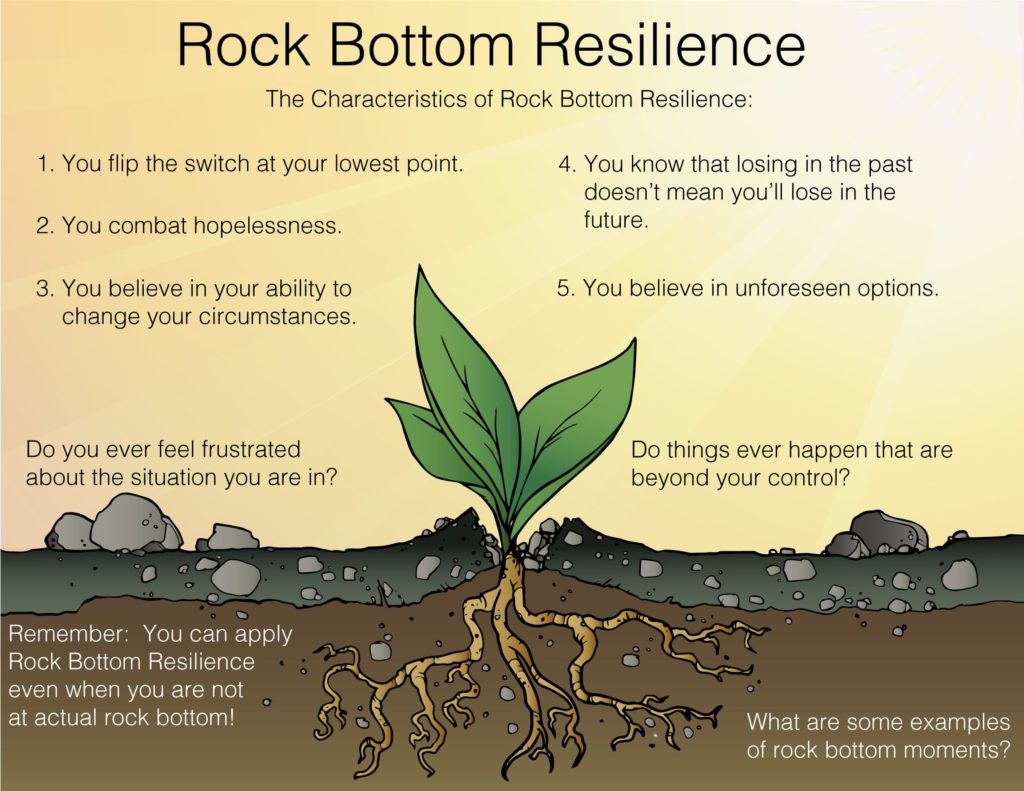Rock Bottom Resilience
What is Rock Bottom Resilience?
Rock Bottom Resilience: Whether you’re at the actual worst moment in your life or are simply “bottoming out,” you have the ability to Flip the Switch at your lowest point. You believe in your ability to change your circumstances, find hope, and fight on. You believe in potential unforeseen options even during your most difficult times. You become increasingly aware that losing in the past does not mean you must lose in the future.

Listen to this Chapter
Hardship: The Human Experience
Job loss. Health problems. Difficult children. Difficult partner. Addiction. Depression. Death.
When we think of “rock bottom” moments in life, often what comes to mind are the jarring adversities listed above. Maybe you or your family members have personally dealt with one, or a few, or even all. Maybe you’ve been fortunate enough to avoid such tremendous life hurdles. Regardless of where you fall on the “Hardship Scale of Life,” you can use Rock Bottom Resilience to combat any pain that crosses your path, large or small.

You may not be able to change your circumstances, but you can change your outlook. You can change the future by simply moving forward.
Characteristics of Rock Bottom Resilience
Think about the people in your life. Or, you could even think about people in the media who have been resilient in the face of rock bottom moments. Most likely, they exhibited some of the following characteristics of Rock Bottom Resilience:
You flip the switch at your lowest point.
Remember our “Flip the Switch” chapter? To refresh your memory, flipping the switch means that you commit to looking at a problem differently. This can be exceptionally difficult during rock bottom moments, but it can also be the start of an important process of healing and resilience.
You combat hopelessness.
How do you avoid sinking into despair when things have gone terribly wrong? One approach is to call into action the other three sources of resilience. Use Relational Resilience by turning to the people who care about and support you, or pressing forward because of the children who depend on you. Pull out Street Resilience to use any anger or sorrow from the situation as fuel. Resource Resilience can help you take a close look at the tools or potential tools you can use to bounce back.
You believe in your ability to change your circumstances.
Change is impossible without belief. No matter how dire a situation, if you can muster up a belief – or even just a hope – that you will one day emerge on the other side of this challenge, your chances of actually doing so instantly increase dramatically.

You know that losing in the past doesn’t mean you’ll lose in the future.
As long as you’re still breathing oxygen, you’re never permanently “stuck.” Maybe you can’t change your circumstances or plight at the moment, but you can change your outlook and your approach to tackling it. You can change the future by simply moving forward with this as your goal.
You believe in unforeseen options.
As you press forward during the most difficult of circumstances, even before you have a reason to not give up, inevitably options and opportunities will appear that weren’t there before, like a plant emerging from dark concrete and finally seeing the sun it only believed existed.
How to Persevere?
So how do you get to a point where you’re good at being resilient in the face of rock bottom moments? Just like any other skill, it takes practice. When you falter, flip the switch (stop for a moment, realize you can turn pain into power, and move forward, committed to being resilient).
Another key component of Rock Bottom Resilience is sheer persistence and perseverance – when it feels like there’s nothing else to hold onto, you just keep going. This act of pressing forward often leads you to the unforeseen options listed above.

It also helps to identify something you’re passionate about – a purpose that you feel you have in the world, a belief system you hold dear, or something that makes you feel fulfilled. During rock bottom moments, turn to your passion. It will help you continue to have a sense of purpose even when things seem dire.
Hope and belief are essential. You have to have a hope for something better in your future, a belief that things can change, and a belief that you can create that change for yourself.
Discussing Rock Bottom Resilience with Your Child
Help your child think of a time when they were dealing with a really difficult challenge. What skills did they use to overcome it? Discuss whether those same skills could help address a current or future challenge.
Brainstorm people who were resilient or successful even though life was really, really hard for them. Examples from the media include people like Oprah Winfrey, Nelson Mandela, Christopher Reeve, or Bethany Hamilton, but you can also think about people in your own circles. What did these people do to emerge from their rock bottom experience?

Review with your children the characteristics of a person with Rock Bottom Resilience. Discuss which ones the family could focus on next time you’re facing a challenge.
Reflection
What sort of “rock bottom” – or simply unpleasant – challenge are you experiencing right now? Look at the characteristics of Rock Bottom Resilience and determine which ones you could focus on to increase your own resilience in the face of this situation.

“If we are able to reframe how we see things when we’re at rock bottom – if we can shift our point of view, interpret something differently – our challenges can become fuel and we can respond more resiliently.“
